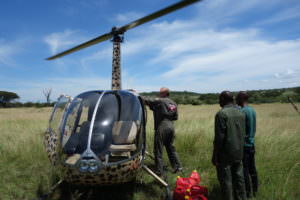 The latest crop raiding season in the Mara (June and July) was so active for the Mara Elephant Project’s Karen Blixen Camp Ree Park Safari helicopter, that in August we needed to suspend our aerial monitoring of all 23 collared elephants because we didn’t have the funds to continue with that important task.
The latest crop raiding season in the Mara (June and July) was so active for the Mara Elephant Project’s Karen Blixen Camp Ree Park Safari helicopter, that in August we needed to suspend our aerial monitoring of all 23 collared elephants because we didn’t have the funds to continue with that important task.
Helicopter Report August 2017
High crop raiding times come along when farmer’s crops are ripe and there hasn’t been much rain in the Mara. The lack of rain and other food sources pushes elephants to extremes and farmer’s ripened crops look quite easy for the taking. In June and July alone MEP responded to over 78 incidents of human-elephant conflict, which pushed our flying hours well above the average 26 hours a month. This increase in necessary flying hours decreased our budget significantly and left no room for our monthly aerial monitoring flights.

Hangzhou leading her herd of 16 elephant back down the Oloololo Escarpment on the 3rd of August. The collar data indicated she was going close to farms and we were able to react before they started crop raiding.
Aerial monitoring flights, on average, take about six to eight hours a month and are an essential part of MEP’s monitoring of our collared elephants. During these flights, we are able to collect important data about the elephants like herd size and have found that the 23 collared elephants we check in on monthly represent between 400 and 600 elephants. One of the most important tasks of this monthly monitoring is to check in on the state of the collar. Collars usually last at most 3 years and it’s essential that MEP gets a good view of a collar on an elephant to mark how it’s holding up.
When we can’t complete aerial monitoring monthly, we won’t be able to collect this important information as was the case in August with Nkoidila. MEP didn’t have a chance in August to get a visual account of the state of her collar and unfortunately, we found out too late that it was frayed and broke off. We not only lost all of the important data we were collecting from her, but also lost track of her herd. Now, it will be extremely difficult to identify her in the Loita area and expensive to pay for a re-collaring.
“There is a good chance that if we had continued to monitor her we would have noticed the fraying collar and replaced it before it broke off and we lost her and her herd.” MEP CEO Marc Goss
Raising funds, between $2,400 and $3,200 a month, to continue the monthly aerial monitoring flights is essential before the next crop raiding season begins in October!


